Excerpts from Jim Conrad's
Naturalist Newsletter
from the February 18, 2018 Newsletter issued from Rancho Regenesis in the woods ±4kms west of Ek Balam Ruins; elevation ~40m (~130 ft), N20.876°, W88.170°; north-central Yucatán, MÉXICO
VARIEGATED YOUNG LEAVES OF SYNGONIUM/ ARROWHEAD VINE
Here as the dry season is starting to get serious with its heat and longtime lack of rain, on the shaded, leaf-littered floor of older parts of the surrounding forest you see freshly emerging, attractively variegated leaves like those shown below:
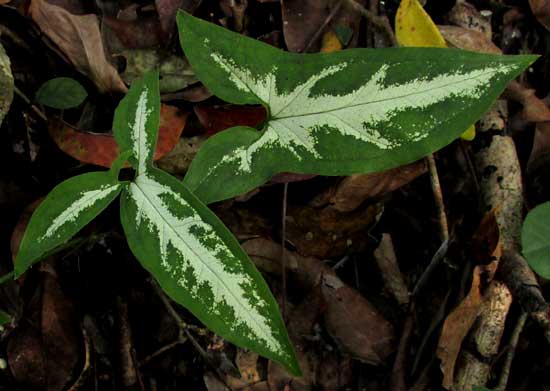
You've probably seen similar foliage on shade-tolerant potted plants up north. When these leaves first emerged I couldn't imagine the plant's identity, because here I've seen no mature plant producing such leaves. Potted plants with such ornamentation, fleshy texture and shape usually are members of the Arum or Jack-in-the-pulpit Family, the Araceae, and I was pretty sure that our emerging leaves also belonged to that family, but still I drew a blank. The breakthrough came once the leaves had developed a little more, producing what's shown below:
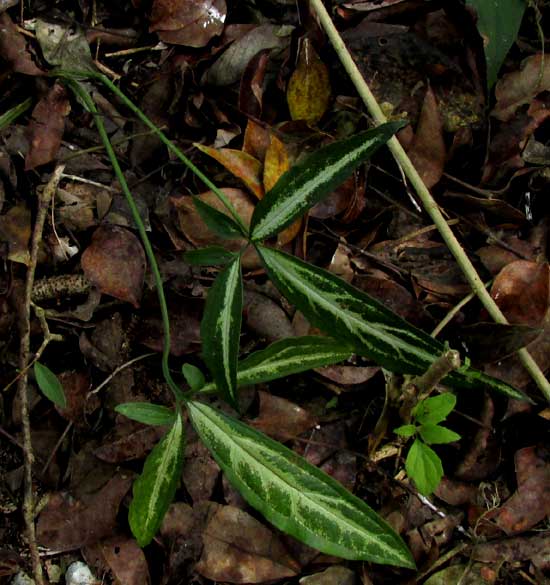
The leaves lose their arrowhead shape and become deeply lobed and compound. Here we do have viny members of the Arum Family with compound leaves such as these, in the genus Syngonium. However, Syngonium vine leaves aren't the least varigated. The next discovery supporting my suspicion that this is a Syngonium came with the discovery of what's shown below:
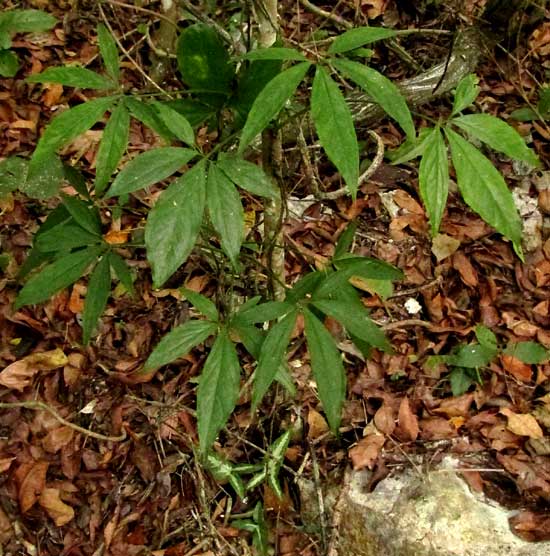
The top ¾ of that image definitely shows leaves a Syngonium vine, and the lower ¼ shows much smaller leaves with arrowhead shapes and variegation. My finger poked into the soil followed the smaller leaves' stem downward until it connected with a much larger stem, which seemed to be the origin of the vine with larger leaves. Therefore, the fancy little leaves emerging nowadays are Syngonium leaves.
At this point in the quest for a solid ID, complications develop. We have two Syngonium species names here we could be dealing with, Syngonium angustatum and Syngonium podophyllum. Some authors regard Syngonium podophyllum as just a form of Syngonium angustatum, in which case our vine would be Syngonium angustatum. However, it seems that most specialists keep the two species apart. With the vegetative material we have here I can't say which it might be, so I'll just call it Syngonium Vine.
Why does the vine feel like it needs to variegate its young leaves and not its older ones? It seems that it'd prefer having no variegation at all, since those white splotches must reduce the leaves photosynthetic capacity. Maybe young leaves benefit from the ornamentation because that provide "disruptive camouflage," which to a leaf-grazer's eye might cause the young leaves to appear less leaflike amid the forest floor's visual clutter.
from the April 24, 2016 Newsletter with notes from a visit to Lacanja Chansayab in the Lacandon Reserve, Chiapas, MÉXICO
SYNGONIUM VINE
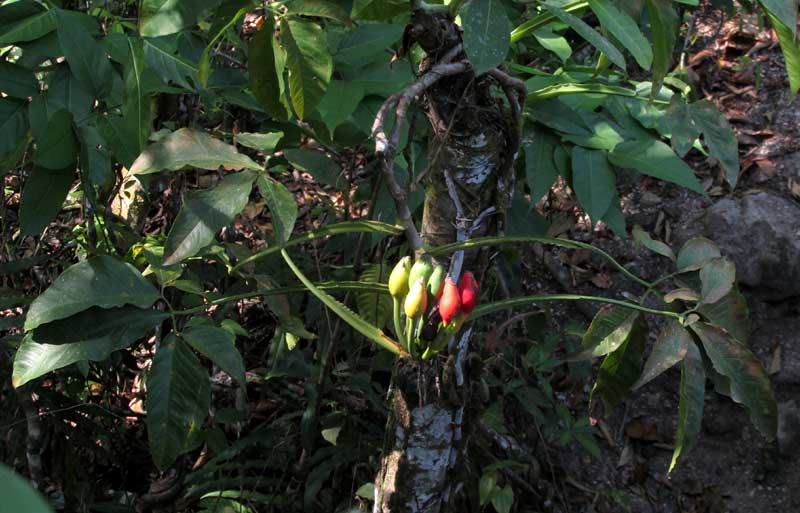
A viny, high-climbing member of the Arum or Jack-in-the-pulpit Family, the Araceae, commonly seen in Chiapas's Lacandon Reserve, is the one shown above.
Notice that the big blades are attached to long, arcing petioles, and that the blades are compound, consisting of several leaflets, very unlike the above Monstera Vine. In the above picture, the cluster of fruiting structures in the center is what catches the eye, and a close-up of that is shown below:
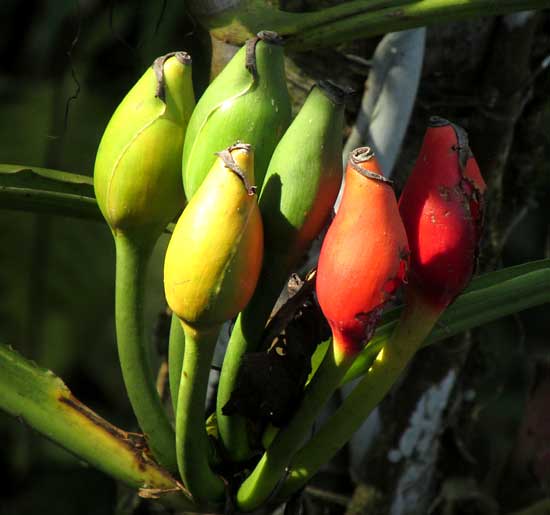
The oval, red-turning things on erect stalks are not fruits but rather what can be called "fruiting spadices." You might recall that flowers in the Arum Family are very small and numerous, packed closely together on a vertical, finger-like structure known as a spadix, with male flowers at the spadix's top, and female ones at the bottom. The entire spadix is accompanied by a leafy "spathe," which partly or completely wraps around the spadix. On the Jack-in-the-pulpit flower, "Jack" is the spadix while the "pulpit" is the spathe.
In the picture, the male part and the part of the spathe wrapping around the male part have fallen off, leaving a scar at the top of the oval "fruiting spadices." The fleshy, red-turning coverings of the "fruiting spadices" are parts of the old spathes that formerly enclosed the female part, or bottom, of the flowering spadix. Inside the mature, red "fruiting spadices" at the right in the picture, the former ovaries now are mature fruits grown together into a fruit-like structure something like an ear of corn. Each "fruiting spadix" is actually a collection of many fruits, which are hidden inside the fruiting body.
This is SYNGONIUM PODOPHYLLUM, a species fairly common in southern Mexico south into South America. It has no good English names so some aroid enthusiasts just to call it Syngonium Vine.
At Hacienda Chichen in north-central Yucatan the vine is planted and we've documented its leaf variation, aerial roots and flowers there, as shown at www.backyardnature.net/yucatan/syngonm.htm
from the February 22, 2019 Newsletter with notes from an October, 2018 camping trip in Chiapas, MÉXICO
FLOWERING SYNGONIUM VINE
Last October 3rd when I was camping in Chiapas, Mexico's southernmost state, climbing a tree along the entry road to Palenque National Park there was a Syngonium vine, its distinctive, palmately compound leaves shown below:
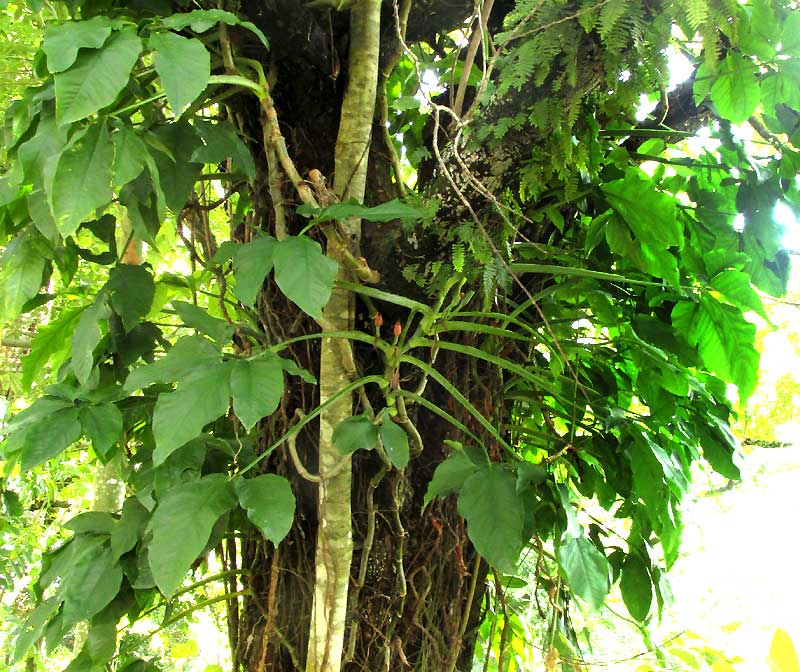
Mostly the flowering had already passed, just leaving a few fruiting heads, some shown below:
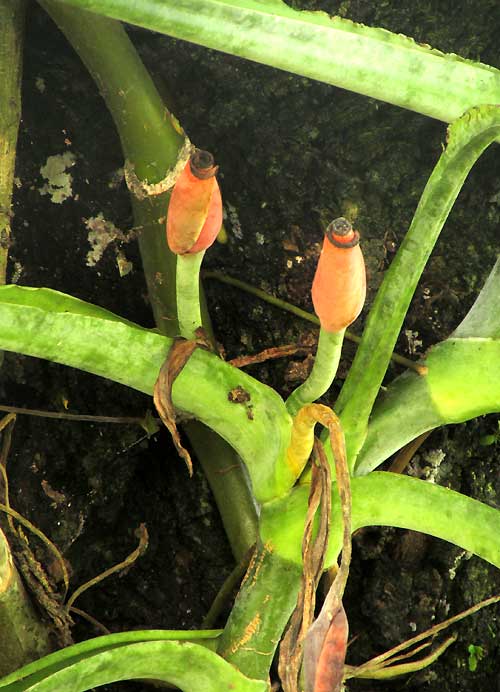
However, there was at least one flowering head still open, seen below:
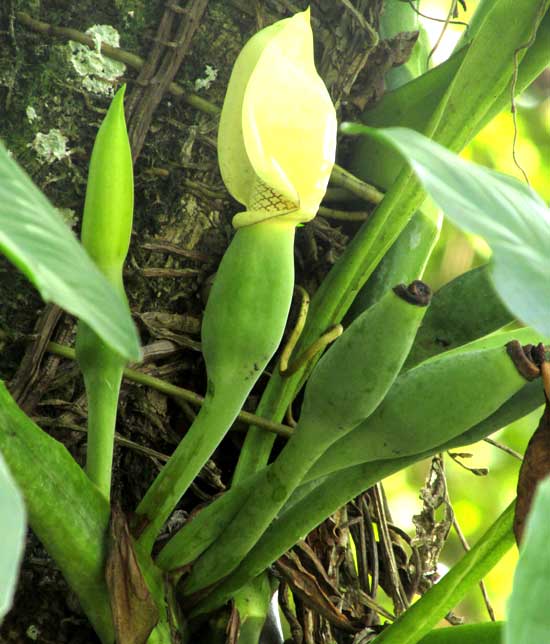
Distinguishing species of the genus Syngonium can be hard, so I was glad to have available mature leaves, fruiting and flowering heads. Best I can tell, this is Syngonium podophyllum, distinguished from the very similar S. angustatum, among other things, by its broader leaflet sections and the silvery sheen, or glaucescence, visible in some of the vegetative parts.